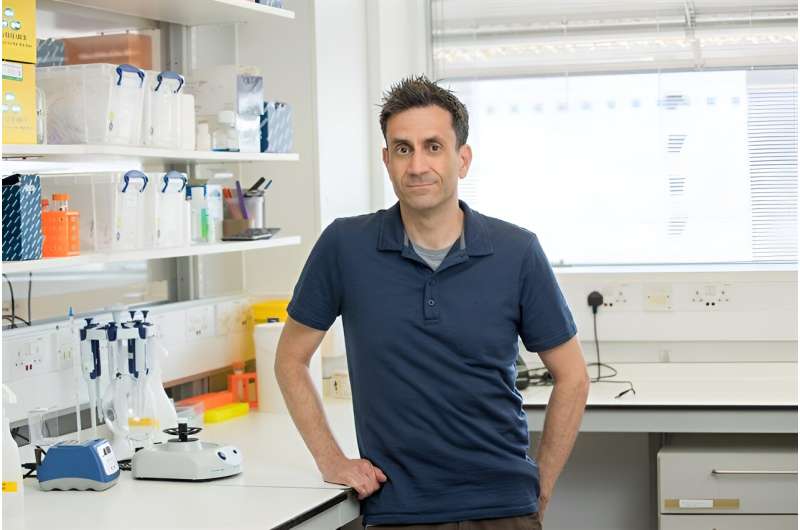This article has been reviewed according to Science X's editorial process and policies. Editors have highlighted the following attributes while ensuring the content's credibility:
fact-checked
trusted source
proofread
Scientists uncover new treatment pathway for rare 'spider web' childhood brain tumors

Researchers have identified the unique features of an exceptionally rare set of childhood brain tumors—a discovery that could pave the way for more effective treatments.
A decade-long study, carried out by a team from The Institute of Cancer Research, London, as part of a European working group, to comprehensively analyze a set of childhood tumors known as gliomatosis cerebri, has been published in the journal Neuro-Oncology.
Gliomatosis cerebri is a highly aggressive type of glioma—a brain tumor that originates in the glial cells, the supporting cells of the brain and spinal cord.
Rather than a solid tumor, gliomatosis cerebri typically presents as a spider's web of cancer threads that spread deep into the brain, making it almost impossible to remove with surgery and difficult to treat with radiotherapy. No chemotherapy has proven to be effective.
Approximately 100 people are diagnosed in the U.S. per year and most survive less than a year. Although gliomatosis cerebri was first identified in 1938, there is still little consensus on its definition, the underlying biology of the disease, or its treatment.
It is currently described by the World Health Organization as a special "growth pattern" of various types of diffuse gliomas, rather than a distinct disease. Previous studies have failed to identify a molecular signature compared with other gliomas in both children and adults.
Global collaboration is key
Because childhood brain tumors like gliomatosis cerebri are so rare, it is difficult to study them in the large numbers needed to make robust conclusions.
Research into gliomatosis cerebri at the ICR is part of an international, collaborative effort. The new study was carried out by the High-Grade Glioma Working Group on behalf of the International Society for Pediatric Oncology Europe (SIOPE). It involved researchers from across the continent, who collected the brain tissue samples needed to carry out the study of 104 children and adolescents with the disease.
New molecular profile for gliomatosis cerebri
Tumor profiling (testing) helps scientists to understand what molecules are driving someone's cancer. This enables clinicians to personalize a patient's treatment based on their tumor profile. In the SIOPE study, the researchers were able to identify a molecular profile for gliomatosis cerebri.
The results of the study showed that two subtypes called pedHGG_RTK2A/B and pedHGG_A/B were both significantly associated with pediatric gliomatosis cerebri.
Additionally, mutations in Epidermal Growth Factor Receptor (EGFR)—a protein found on the surface of some cells—and in the BCOR gene, as well as rearrangements of chromosome 6 were the most common genetic features. This discovery could help research teams to focus on identifying potential drug targets for gliomatosis cerebri in the future.
Professor Chris Jones, professor of childhood brain tumor biology at the ICR, said, "In recent years, we have observed that childhood brain tumors are different from those in adults and that they are not one entity in themselves. Instead, there are many different subtypes requiring separate investigation.
"In this study, we demonstrated that gliomatosis cerebri tumors behave very aggressively and differ from other types of gliomas found in children.
"Contrary to previous research, the SIOPE study has shown that there are distinct molecular and clinical features of gliomatosis cerebri and this provides evidence that it ought to be re-considered as a separate entity. Now that we know it is a distinct tumor type, researchers around the world can focus their efforts on its specific biology.
"This could eventually enable clinicians to treat cases of gliomatosis cerebri in a more precise way. During our research, we identified potential drug targets such as EGFR which could be tested as targeted therapies in future clinical trials."
Vidhu Menon, whose son Rudy died from gliomatosis cerebri in 2013, set up The Rudy A Menon Foundation in his memory. She said, "The publication of the SIOPE study on pediatric GC is one of the biggest steps forward where the research on this disease is concerned. This will become the cornerstone for further understanding & finding effective treatments for this disease globally.
"The SIOPE study has been a successful international collaboration with Professor Chris Jones spearheading the research and we are grateful to him for working on this over the years and seeing it come to fruition. The Rudy Mission is proud to be associated with Professor Jones and the ICR."
More information: Gunther Nussbaumer et al, Gliomatosis cerebri in children: A poor prognostic phenotype of diffuse gliomas with a distinct molecular profile, Neuro-Oncology (2024). DOI: 10.1093/neuonc/noae080


















